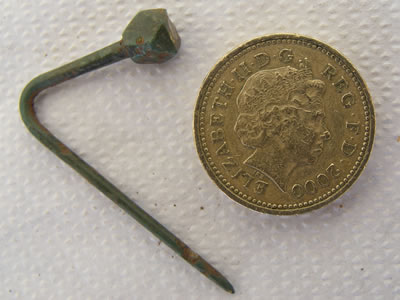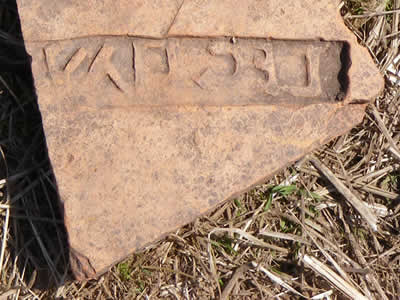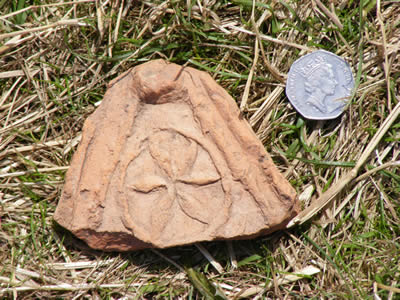|
|
|
|
|
|
| |
|
|
|
| |
From June 16th until July 25th 2008 archaeologists excavated what was believed to be a Roman warehouse in Priory Field Caerleon... |
|
|
|
|
|
|
| |
Archaeologists from Cardiff University and UCL continued their exploration of the Roman Legionary Fortress started in the summer of 2007.
They dug in Priory Field on what was previously believed to be a warehouse - possibly the fortress's main warehouse. It is thought that also under the field lie the remains of granaries and barrack blocks. |
|
This section of the fortress would have been an ideal location for a warehouse, being near the gate that lead to the wharfs on the River Usk. The warehouse would have stored supplies and provisions for the 6000 soldiers stationed here.
The excavation area had not been disturbed by previous digs so the finds were expected to be exciting! |
|
|
|
|
|
|
|
|
|
|
|
|
|
|
|
|
| |
 The area being explored
The area being explored
(looking the opposite way to the aerial photo) |
|
 Even at this early stage the line of a wall can be seen.
Even at this early stage the line of a wall can be seen. |
|
|
|
|
|
|
 Composite photo of the dig in progress July 3rd 2008. NB the trench is actually rectangular!
Composite photo of the dig in progress July 3rd 2008. NB the trench is actually rectangular! |
|
|
|
|
|
|
|
|
|
|
 Flagstone floor lying over the line of a wall (notice the hump just in front of the archaeologist making a detailed record of this section).
Flagstone floor lying over the line of a wall (notice the hump just in front of the archaeologist making a detailed record of this section). |
|
The large amounts of rubble lying on top of the Roman remains (as shown on 'geophys' surveys) indicate later occupation. Pieces of Medieval pottery were found in this layer, so too were Roman finds which must have been disturbed along with the movement of the stones.
In the northern corner a flagstone floor was found running over the top of the line of a Roman wall. This flooring has sunk either side of the wall, the stones were cracked probably indicating quite heavy use.
The interesting question is what date are these later buildings? Do some of them go right back to the end of the Roman occupation of the site and just after? No doubt the archaeologists will be trying to answer these questions before they return to continue the dig in 2009. For sure this excavation will not only clarify what Roman building was on this site but will also tell us more of what went on here in the late fourth century and after the Romans left - an even more tantalizing prospect! |
|
|
|
|
|
|
|
|
|
|
Some of the finds... |
|
|
|
|
|
|
|
 |
|
Inscribed stone - >FLAVI RVFI PP
Centurial stones such as this were built into the walls to show which century of soldiers had constructed the building. This stone marked the work of the century under the command of Flavi(us) Ruf(us). PP probably stood for Primus Pilus (chief Centurion or senior centurion).
Often these stones were crudely executed as they were sometimes plastered over. Probably because of the importance of this centurion the work is more elaborate, suggesting it would not have been covered with plaster.
For more on Centurial stones follow this link. |
|
|
|
|
|
|
|
|
|
|
|
Legionary's ceremonial lance?
This is believed to be a sort of spear head for ceremonial use, probably belonging to a high ranking Roman soldier. If this is the case, this could be the first such find in the UK. The find will be x-rayed to get a clearer picture of its original state.
To watch a video clip on the BBC website about this object follow this link (opens in a new window, to return here close the window).
Excitement over! Closer examination has shown it to be a shield handle |
|
|
 ©BBC
©BBC
To watch a video about the find click on the picture above.
(Opens in a new window.) |
|
|
|
|
|
|
|
|
|
|
 |
|
One of the coins found.
The coins found in the topsoil date from the late 3rd and the 4th century.
These point to occupation and use of some kind as late as 380 AD. Further excavation should shed some light on what the area was used for.
(Inset shows the find alongside a £1 coin.) |
|
|
|
|
|
|
|
|
 |
|
Copper or bronze hair pin. |
|
|
|
|
|
|
|
|
 |
|
A large amount of roof tile. Some pieces bearing the Legionary stamp LEG II AVG.
This particular stamp is reversed. Also the formation of the letters makes it one of a less common type. It's interesting that although the stamp is small in comparison to the size of the pieces of tile, in most cases the tile is broken through the stamp. |
|
|
|
|
|
|
|
|
 |
|
Part of an antefix. To see a complete antefix, and for an explanation of its use follow this link to a page on the "Gathering The Jewels" website. (Opens in a new window, close it to return here.) |
|
|
|
|
|
|
|
|
 |
|
Carved soft stone.
It's not known yet whether this carving of vine leaves is Roman or of a later date. It was found amongst the rubble covering the Roman remains (as were all the finds above).
It could well be a fragment of a Roman altar. |
|
|
| |
|
|
|
|
|
|
|
|
|
All photos copyright Caerleon Net unless stated otherwise. Many thanks to the members of the excavation team for their time and assistance. |
|
This project, directed by Dr. Peter Guest and Dr. Andrew Gardner, is generously supported by Cadw, National Roman Legion Museum, and many members of the Caerleon community. |
|
|
|
|
|
|

